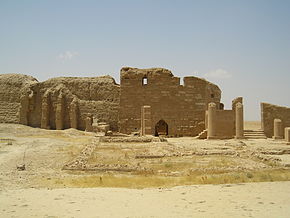Dura-Europos

Temple of Bel at Dura-Europos
|
|
| Location | near Salhiyah, Syria |
|---|---|
| Coordinates | 34°44′49″N 40°43′48″E / 34.747°N 40.730°E |
| Type | settlement |
| History | |
| Founded | c. 300 BC |
| Abandoned | 256–257 AD |
| Cultures | Hellenistic, Parthian, Roman |
| Site notes | |
| Excavation dates | 1922—1937 1986—present |
| Archaeologists |
James Henry Breasted Franz Cumont Michael Rostovtzeff Pierre Leriche |
| Condition | Demolished |
| Ownership | Public |
| Public access | Yes |
Dura-Europos (Greek: Δοῦρα Εὐρωπός), also spelled Dura-Europus, was a Hellenistic, Parthian and Roman border city built on an escarpment 90 metres (300 feet) above the right bank of the Euphrates river. It is located near the village of Salhiyé, in today's Syria. In 113 BC, Parthians conquered the city, and held it, with one brief Roman intermission (114 AD), until 165 AD. Under Parthian rule, it became an important provincial administrative center. The Romans decisively captured Dura-Europos in 165 AD and greatly enlarged it as their easternmost stronghold in Mesopotamia, until it was captured by Sassanians after a siege in 256-7 AD. Its population was deported, and after it was abandoned, it was covered by sand and mud and disappeared from sight.
Dura-Europos is extremely important for archaeological reasons. As it was abandoned after its conquest in 256-7 AD, nothing was built over it and no later building programs obscured the architectonic features of the ancient city. Its location on the edge of empires made for a co-mingling of cultural traditions, much of which was preserved under the city's ruins. Some remarkable finds have been brought to light, including numerous temples, wall decorations, inscriptions, military equipment, tombs, and even dramatic evidence of the Sassanian siege. After being severely looted by the Islamic State in the ongoing Syrian Civil War, it was demolished by ISIS.
Originally a fortress, it was founded in 303 BC with the name Dura by the Seleucids on the intersection of an east-west trade route and the trade route along the Euphrates. Dura controlled the river crossing on the route between his newly founded cities of Antioch and Seleucia on the Tigris. Its rebuilding as a great city built after the Hippodamian model, with rectangular blocks defined by cross-streets ranged round a large central agora, was formally laid out in the 2nd century BC. The traditional view of Dura-Europos as a great caravan city is becoming nuanced by the discoveries of locally made manufactures and traces of close ties with Palmyra (James). Instead, Dura Europos owed its development to its role as a regional capital.
...
Wikipedia

